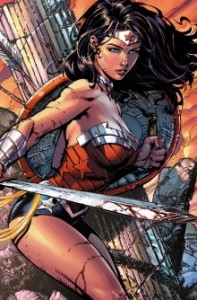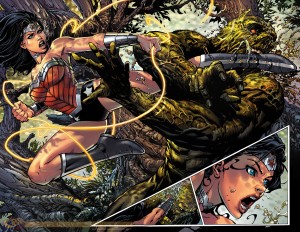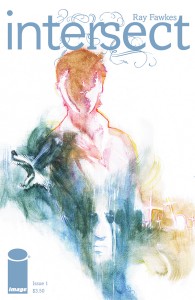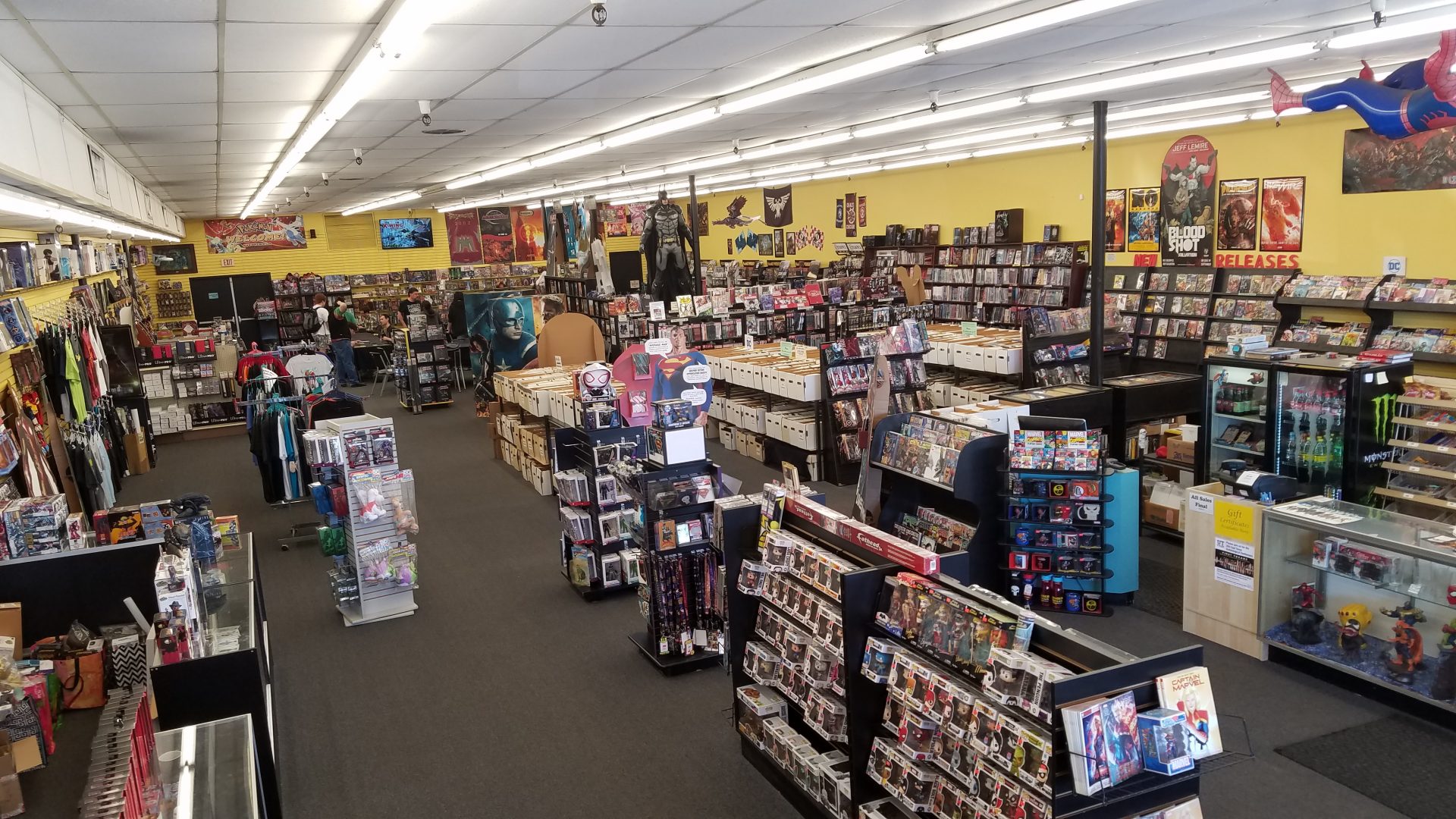So, we’re going over two books this week – I knew I was gonna want to talk about the start of Meredith and David Finch’s run on Wonder Woman, good or bad, but while it wasn’t enough for a full article, I was also moved to write about Ray Fawkes’ intriguing new Image title, Intersect.
 First off, Wonder Woman. I went into this one with all the trepidation in the world. Wonder Woman’s not a character I could ever bring myself to care overmuch about prior to her reinvigoration at the hands of Brian Azzarello and Cliff Chiang three years ago, and while I knew it was his wife Meredith Finch ostensibly writing this one, David Finch’s last writing job (the mercifully short-lived pre-52 Batman: The Dark Knight series) was…pretty subpar. So I was worried – but It brings me great joy to report that I worried in vain. In hindsight, I really probably shouldn’t have worried at all. If I’ve learned anything as a comic fan at this point, it’s that usually when DC says “trust us – we know what we’re doing on this”, you should generally listen. Their editorial policies certainly have their downsides – one need look no further than any one of a hundred different internet comment sections daily to learn all about their failings. But when a popular writer leaves a book (a la Scott Snyder on Swamp Thing, or James Robinson on Earth 2), DC generally has a plan in place to keep the book interesting (and, more importantly, to keep it selling).
First off, Wonder Woman. I went into this one with all the trepidation in the world. Wonder Woman’s not a character I could ever bring myself to care overmuch about prior to her reinvigoration at the hands of Brian Azzarello and Cliff Chiang three years ago, and while I knew it was his wife Meredith Finch ostensibly writing this one, David Finch’s last writing job (the mercifully short-lived pre-52 Batman: The Dark Knight series) was…pretty subpar. So I was worried – but It brings me great joy to report that I worried in vain. In hindsight, I really probably shouldn’t have worried at all. If I’ve learned anything as a comic fan at this point, it’s that usually when DC says “trust us – we know what we’re doing on this”, you should generally listen. Their editorial policies certainly have their downsides – one need look no further than any one of a hundred different internet comment sections daily to learn all about their failings. But when a popular writer leaves a book (a la Scott Snyder on Swamp Thing, or James Robinson on Earth 2), DC generally has a plan in place to keep the book interesting (and, more importantly, to keep it selling).
For someone with so few writing credits to her name, Meredith Finch has a remarkably assured voice – not just for the newly-minted God of War, but for a big chunk of the rest of DC’s A-list stable as well. The Finchs said in interviews leading in to their run that they wanted to
reconnect Diana with the larger DCU, and this first issue completely delivers on that promise. Some may feel it’s gimmicky, with the entire rest of the Justice League and Swamp Thing all showing up in this issue, but it feels natural to the story, and Wonder Woman is always the focus – the rest are all guest stars (although Swamp Thing does have a line that entirely steals the show).

Speaking of Swamp Thing, the fight between him and Wonder Woman illustrates everything I’ve always loved about DC’s characters. Marvel has made their fortune trotting their heroes out every summer to punch each other silly in various wars both Civil and Secret, but DC’s hero fights by and large tend to be more rational and less sales-driven (not that there’s anything inherently wrong with driving sales). Case in point, this issue, where it’s entirely logical that Diana, who doesn’t know Swamp Thing, would go after him given the circumstances, but rather than get angry and retaliate, Swampy defends himself, but ends the fight and explains the situation as quickly as possible. Call me silly, but I like it when my heroic characters don’t completely bash each other’s brains in over misunderstandings (for a similar nipped-in-the-bud hero fight, check out the excellent Justice League United Annual # 1).
The dialogue is, frankly, top-notch. Wonder Woman’s discussion with Aquaman in her jet (her invisible jet!) completely sets up both characters for someone who hasn’t been reading either of their books, but also acts as an extension of the plot, and feels entirely naturalistic. Speaking of the plot, while it’s still a mystery what this new arc will actually center around, one of my other worries surrounding this new run was that the left turn stylistically would cause all the great work Azzarello did to be forgotten about or swept aside – not so, thankfully, as we spend a fair amount of time on Paradise Island dealing with the fallout of Diana’s decision to forcibly introduce males into the island’s population during the final battle with the First Born. Like the rest of the issue, this is done in such a way as to be new-reader friendly, but also lets us know that what came before hasn’t been forgotten.
The art is also great, but it’s David Finch. If you like anything David Finch has drawn over the last 20 years, you will also like this. If you don’t, well, you may not like this. At this point, he’s a known quantity, and he delivers exactly as expected. Personally, I’m a huge fan of his style, and I’m very glad that the writing is also good, making for a book I’m happy to keep on my pull-list for many issues to come.
 Now, didn’t I say at the beginning that there was another book I wanted to talk about? Oh yeah – Intersect. This is an odd one, and it may not last very long, but I really hope it finds an audience. Writer/Artist Ray Fawkes calls the series “a complete realization of a deeply haunting notion I’ve been eager to share for years”, and it is definitely something a bit new in terms of horror comics (when’s the last time you saw a horror book that completely eschews the use of the color black in the art?). Now, it’s fair to mention at this point that I’m a huge fan of works that explore dream logic. Not the sanitized, rational progression of events from something like Inception (which was an entertaining movie, don’t get me wrong), but the messy, filthy, illogical, random expressions of our subconscious that make perfect sense and are often terrifying while we’re asleep, but are completely incomprehensible once we’re vertical again. Works like David Lynch’s Eraserhead, Jason Beene’s Symon, and nearly everything created by Jonatan Söderström are what I’m talking about here, and now we can add Ray Fawkes’ Intersect to that list.
Now, didn’t I say at the beginning that there was another book I wanted to talk about? Oh yeah – Intersect. This is an odd one, and it may not last very long, but I really hope it finds an audience. Writer/Artist Ray Fawkes calls the series “a complete realization of a deeply haunting notion I’ve been eager to share for years”, and it is definitely something a bit new in terms of horror comics (when’s the last time you saw a horror book that completely eschews the use of the color black in the art?). Now, it’s fair to mention at this point that I’m a huge fan of works that explore dream logic. Not the sanitized, rational progression of events from something like Inception (which was an entertaining movie, don’t get me wrong), but the messy, filthy, illogical, random expressions of our subconscious that make perfect sense and are often terrifying while we’re asleep, but are completely incomprehensible once we’re vertical again. Works like David Lynch’s Eraserhead, Jason Beene’s Symon, and nearly everything created by Jonatan Söderström are what I’m talking about here, and now we can add Ray Fawkes’ Intersect to that list.
Trying to explain the plot of Intersect is much like trying to explain a really cool dream you had around the breakfast table – it doesn’t really work well in retrospect. It’s power lies in the way in which it’s presented, with panels bleeding into each other, characters speaking backwards, and the drowsy air of nightmare-fueled paranoia that permeates the book like flies buzzing around a day-old corpse.
I wasn’t the biggest fan of the art, though. This is entirely Ray Fawkes’ baby, so he, previously only a writer, handles art duties as well on this book. I would have preferred looking at a style that isn’t so initially off-putting, but I’m not sure a different style would work for the kind of story he’s trying to tell. The figures have to be sketchy and ill-defined, because that just comes with the territory of a nightmare. Lucky would not be as frightening as he is if we could ever see him clearly. Like the best horror filmmakers, Fawkes knows that an imagined beast is much more terrifying than the real thing. While I initially found it very difficult to process, I really have to praise Fawkes’ use of color, simply because it is so off-putting and outside the norm. A nightmare dreamscape is not the kind of place you’d expect to find a Kabuki-esque field of white backgrounds and pastel pencils, but I’m warming to the concept.
Scott Snyder’s Wytches has, mostly deservedly, been demanding most of the buzz limelight for horror books lately, but it you’re a fan of David Lynch, Lovecraft, Silent Hill, or if you’ve ever been fascinated by what might be walking around in that fog bank over there, then you need to be reading Intersect. It’s definitely one of the most unique comics I’ve read in some time, and I can’t wait for another taste of the awful things running rampant in Ray Fawkes’ head.


